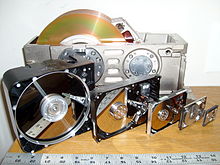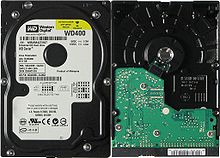Drive (computer)


A drive or storage device - is a device for write and / or read access to a storage medium for digital data . The storage medium is also called a data carrier or, depending on its functionality, mass storage . Drives can be divided into those for removable media ( magnetic tape , floppy disk , CD , DVD , etc.) and hard disks or solid-state drives (SSD), which the user can change during operation. They can be built into a computer (internal drive) or a separate device connected to the computer (external drive).
Demarcation
While the word “drive” implies a mechanical device, there are also media with memory chips that do not require movable mechanics to be accessed. These include memory cards , USB sticks , internal storage devices, etc. Although such devices are not drives in the strict sense, they are also referred to as such because they have the same function from the perspective of the user.
In order to handle large volumes of data, separate systems are set up that are only used for data storage. These are connected to the application server via network (NAS) using special protocols such as iSCSI , or in a special storage area network (SAN), for example with Fiber Channel . Such data storage devices are referred to as hard disk subsystems , tape libraries and CD / DVD / WORM juke boxes.
Volume
A volume is also often referred to as a drive in German . Traditionally, this is the same systems the case, which also use drive letters, such as Windows from Microsoft .
Drive letter
On some systems, like u. a. CP / M , DOS , Windows and OS / 2 , the data memory is made available from volumes like drives in the operating system as drive letters or can be addressed via them. Device drivers for external devices, such as card readers or floppy disk drives, provide the available removable media as drive letters in the system.
In addition to physical drives in the true sense - as hardware - there are various methods that cause through the operating system for the user "drives" ( English volumes are visible), the to-one-one correspondence have to physical drives: partitions , a drive into multiple file systems to partition, logical drives for more complex distributes file systems on drives, RAID systems, merge to multiple drives, and virtual disks , physical drives on software or operating system side emulate, with individual content media in image - file is kept.
Free areas of the main memory can also be used as drives in this sense. These are known as RAM disks . Since the contents of the main memory are lost when the computer is restarted or switched off, RAM disks cannot be used as mass storage devices . Their main advantage lies in the significantly shorter access times and much higher data transfer rates .
Web links
References and comments
- ↑ General information on storage devices - at the Dresden-Bühlau grammar school , categorized under: Learning material for subject area 2 of the computer science curriculum for class 8; last changed on November 28, 2010.
- ↑ Group # 3: Definition of the memory. Retrieved March 24, 2018 .

